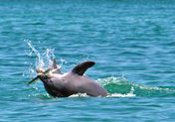Dolphin SMART: 40th Anniversary of the MMPA
Dolphin SMART: A Unique Conservation Program Benefiting Dolphins and Businesses
The energetic behaviors of dolphins tend to fascinate us all. Many people now seek out any opportunity to gain a small glimpse into the world of wild dolphins. This phenomenon has created a tourism explosion driving most tropical vacation spots to now feature some element of dolphin viewing. However, before you choose your dolphin viewing tour, it is important to consider a few, very important points.

Bottlenose dolphin feeding, Key West, FL
Photo Credit: Dolphin Ecology Project
Kerplunk! Swoosh! Gulp!

Spinner dolphin mid-spin off the Hawaiian Islands.
Photo Credit: NOAA Fisheries, Pacific Islands Region
Whistle! Spin! Splash!
Sometimes it is easy to forget that lively coastal dolphins are vulnerable to disturbance by boats and people. In fact, the Marine Mammal Protection Act protects dolphins from any form of harassment that can disturb their natural behaviors.
Dolphins depend on their coastal homes for protection from predators, to care for their young, and to hunt for food. Disruption by people and boats can prevent dolphins from accomplishing these important survival behaviors. In extreme cases, frequent, repeat disturbance to dolphins will cause them to permanently move away from their resident bay to another area, away from humans but potentially less optimal for their survival.
This is not only bad for the dolphins, but for the local tourism businesses as well. In some coastal towns, specifically in the Southeast United States and Hawaii, a sizable portion of the economy depends on dolphin-viewing business.
Protection of dolphins and their coastal homes is crucial for both wild dolphin conservation efforts and economic sustainability of dolphin-viewing businesses.
So how can you help dolphins while supporting local businesses and enjoying the behaviors of wild dolphins? Become Dolphin SMART!
What is Dolphin SMART?
Dolphin SMART is a one-of-a-kind program that combines responsible viewing and advertising practices; educational trainings and materials; field research; and outreach to benefit both dolphins and participating dolphin-viewing businesses.
Dolphin SMART originally began in the Florida Keys National Marine Sanctuary in 2007 where there was a heightened amount of dolphin viewing and boating activity in a small area. This grass-roots voluntary program was developed in a pay-it-forward style.
The dolphin-viewing businesses that participate receive a number of incentives, including training, press releases, educational and marketing materials, and an enhanced tour experience for their customers, which results in increased bookings. These businesses then pay it forward by educating their guests on how to responsibly view dolphins while also responsibly viewing the dolphins on their own tours, thus minimizing disturbance to the animals.

Stay back 50 yards from dolphins
Move away cautiously if dolphins show signs of disturbance
Always put your engine in neutral when dolphins are near
Refrain from feeding, touching, or swimming with wild dolphins
Teach others to be Dolphin SMART
Since the original Dolphin SMART program implementation in 2007, the program has rapidly expanded to a national level and now includes operators in Orange Beach, Alabama, along the southwest Florida coast, and in the Hawaiian Islands. From bottlenose dolphins in the Southeast to spinner dolphins in Hawaii, these coastal dolphin species face similar challenges of balancing the constant threat of disturbance from boats and people while also engaging in the behaviors necessary for survival. By choosing Dolphin SMART, you are supporting businesses that have made a commitment to helping protect these dolphins while also running a tour in a forward-thinking manner that can sustain business as well as the dolphins' survival by minimizing disturbance. Dolphin SMART is a win-win for businesses, guests, and the dolphins.
When booking a wild dolphin viewing tour, "Look before you book!" Seek businesses with the Dolphin SMART logo and current year on boat decals, flags, and businesses advertisements. Or, visit www.dolphinsmart.org to find Dolphin SMART businesses. If Dolphin SMART is not yet in the area, remember the cornerstones of the program when choosing a tour: responsible viewing and advertising.

If you are embarking on your own boating excursion, there are some simple guidelines you can follow that can help you improve your experience and give you peace of mind that the dolphins are not being disturbed. It is important to stay 50 yards away when approaching dolphins; this simple rule allows the dolphins to continue their activities but you can gain an unobtrusive glimpse into their daily lives. Bring binoculars to spot interesting behaviors like aerial displays or feeding from safe-viewing distances. If the dolphins come closer on their own accord, then enjoy the close-up view. But remember to never feed wild dolphins—it has harmful consequences for the dolphins and is also illegal.
In waters from Florida to Hawaii, everyone can become a dolphin steward while being rewarded with seeing fascinating, natural, wild behavior by booking Dolphin SMART and viewing wild dolphins responsibly!
Updated: May 30, 2012
